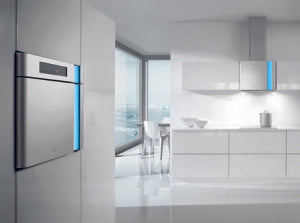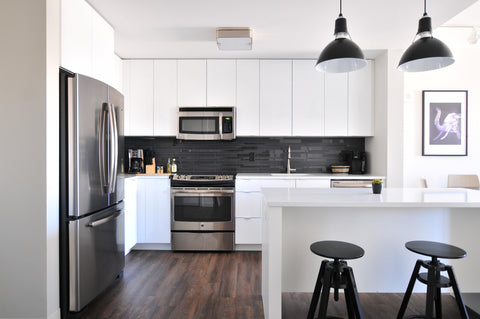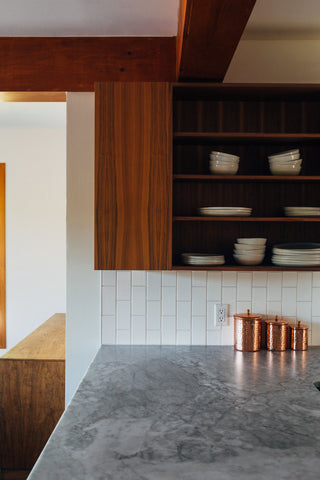March 04, 2014

Budget
The very first question you should ask yourself after you decide to go ahead with your kitchen renovation is this. "How much can I afford?"
You cannot ignore this question.
You cannot pretend this is not an issue. Moreover, you have to be brutally honest with yourself.
You have to know exactly how much money you can spend on this project.
Do not roughly estimate or guestimate. You need to be precise. You need to ask yourself several things:
How much can I afford - really?
Do I or can I take out a home equity or other type of loan?
How much do I want to spend?
Can I extend my line of credit or borrow money?
Do I want to borrow money from family and/or friends? Is this an option?
You can opt for additional financing.
You should, however, consider whether this is essential.
Will you be able to pay it back?
Is the need for a new kitchen that urgent?
Can you handle doing the work over time rather than all at once?
Once you honestly set and accept your budget for this project, you can consider planning on a depth.
At the same time, you may look at ways to decrease costs.
This will help you stretch your money. It may allow you to extend or increase the size or depth of the project.
Budget-conscious planning is a means of reducing the overall cost without sacrificing the entire project.
It is a way of decreasing the amount of money you need to spend while achieving your goal. Look at what really needs to be done.
Your assessment list will help.
If you have sufficient cupboard space, why replace them?
Consider a cosmetic overhaul.
You can alter the style by sanding them down, repainting and perhaps updating the details.
The same approach applies to things like counter tops and counter space.
You may be able to resurface them instead of replacing them.
Update the small details of your kitchen.
At a minimal cost, you can alter the look of your kitchen subtly. You can replace the door and drawer knobs. You can install new designer-style covers for the receptacles.
Perhaps, you can replace the cupboard doors or remove them to open them up.
Maybe new light coverings may help or perhaps using different types of bulbs.
Purchase some materials from a Habitat for Humanity, salvage yards or gently used stores.
These could include doors, doorknobs, tables, and other similar items. You may be able to locate uniquely styled items in these outlets.
Check for rebates.
Often, there will be incentives to upgrade such things as dishwashers and other appliances.
These frequently centre around green or power wise movements in the industry or at the local, state or national level.
Always consider the current location of electrical and plumbing systems.
In installing sinks and other water-dependent items, you can keep costs down if you decide to retain them in their same location.
In other words, try to keep all the plumbing fixtures on the same wall or in the same spot they currently occupy.
Always consider alternative materials. If you want a stone countertop in the kitchen, considerably less than the gold standard.
Purchase manmade copies.
They can be distinctive but cheaper than the more expensive stone.
Consider copies of antiques rather than originals.
Buy made-to-order cabinetry. You can play with the design and the pattern.
Consider storage units that save space but do not cost much. Try hanging cups, restaurant or café style.
Opt for utensil bars. These are S-rings swinging from a rack. This stainless steel bar acts as an excellent place to store and display cutlery.
It also provides quick and easy access. Great for larger utensils.
Use your imagination to come up with cheaper but stylish and practical alternatives
Perhaps, you could consider a shop counter as the basis for your island or countertop space.
If you concentrate and gather suggestions from the net, books, your friends and home and design magazines, you will be able to come up with ways of reducing the cost.
This will make the remodeling process easier.
It will also give you the kitchen you want at a reduced price. It may, if you are creative and versatile, give your kitchen a truly unique, innovative - and talked about, style.

Hidden Costs
When you are examining the figures for your kitchen renovation, be sure to look at the less obvious costs.
If you have gone through the renovation or remodeling process in the past, you are already aware of these covert figures. If not, make sure you know about them.
They have a major impact on your budget.
Hidden costs come in a variety of types.
Take, for example, plumbing. You have your eye on a certain sink. You know the cost of the make and model. You even know where to get it on sale. You take the figure, adding any other occurring costs -, e.g., taxes, ordering and any shipping and handling costs.
You then place the total cost in your budget. Fine, right? It is fine to an extent.
What you need to look at are the less obvious costs associated with the sink.
You will have to pay for installation fees. This may mean hiring a plumber.
You may also have to pay for disconnecting the water supplying of the old sink. You then have to pay a re-connection fee.
The true cost of a sink should, therefore, include purchase cost, disconnection fees, installation and reconnection fees.
Other hidden costs encompass a variety of problems and situations.
You may have to install a smoke detector and purchase a fire extinguisher. When you are renovating, you might run across some unanticipated problem.
The pipes may be found to suffer from corrosion. The floorboards may be rotten. There could be mold or asbestos.
You may have to update the electrical wiring.
There could be problems laying the gas line.
One item many forget is food.
Since you are without a kitchen, you will probably be eating out more. If things do not proceed as planned, this may extend beyond the expected date.
The longer you are forced to eat out, the more it will cost you. You have to add this hidden or indirect cost into your budget.
No matter what the cost is - open or hidden, always be prepared.
Do allow extra time and money in your budget for the purchase of unexpected necessities. Estimate higher rather than lower.
Above all, do not simply expect the unexpected but keep a contingency fund as an integral part of the overall budget. This will help prevent you from any unpleasant surprises.
Try to look at your kitchen renovation from all angles. Remember you have a budget. You need to stick to it.
Remodeling any room is stressful. Why increase the stress levels by going over budget?
Timeline
A crucial part of realistic planning is figuring out your time frame.
Time has something in common with your budget. It is too easy to underestimate.
Like your budget, your timeline may easily go awry if you do not take care to factor in possible glitches.
As with the budget, you need to be honest with yourself.
The first question you need to ask yourself and any other person involved is this: "How long can you go without a functioning kitchen?"
In kitchen remodeling, you are usually left without an active cooking facility.
What are your plans?
Is there a room you can make into a functioning kitchen?
Can you eat out during this time?
Can you run away on holiday?
If it is summer, maybe you can barbeque for this entire remodeling period?
Whatever your preference, make sure you gear toward a time frame that matches your tolerance level.
Furthermore, take care that all the tasks conform to a specific deadline.
This, of course, will be a flexible deadline. You must take into consideration that anything that could possibly go wrong- just might.
Sure, your kitchen remodeling job may proceed without a hitch. Yet again, it will probably not.
What can go wrong with your immaculate schedule? - A host or a veritable hoard of things!
Everything can and does take longer in most kitchen remodeling jobs.
The problems can and frequently do include the following:
Shipping delays - your materials are not arriving to your supplier or contractor or home on the arranged date.
Delays with a contractor, a plumber or a friend who is helping out. A strike of delivery agents, suppliers, tradespeople.
A promised part or appliance or other facet is no longer available. Materials arrive at the wrong size, shape, colour etc.

Spatial Considerations
One of the most important factors in planning the real kitchen is its size.
While you may dream about a kitchen the size of a football field, you may not be able to build it.
Your kitchen is a set size.
You may or may not be able to expand it.
Your budget may not permit you to knock down walls or build an extension.
The structural elements may also not permit expansion.
You must realize these facts and work with them.
Knowing the exact size of the current kitchen is essential to planning the new one.
Knowing the limitations should not dampen the possibilities.
You need to rethink the design formulating in your head.
You will have to work with what you've got if you want to get what you need and desire.
There are several ways to do this.
Investigate the various options to see what meets your specific requirement. This could involve gutting the interior. It could mean rearranging the pattern of traffic by moving the basis of the kitchen triangle. It could mean discovering new ways of storing items.
Bigger cupboards and hide-a-way storage may answer your need
Modern technology may reduce the space taken up by older appliances.
Painting and changing the style could also give you the illusion of spatial depth. Be thorough in your research.
Check out all possible sources.
Look at the recent remodeling jobs of your friends and family members.
Go online or visit a library. Visit model homes.
The more you discover now, the higher the chance you find the right solution to your spatial needs.
Size Matters
Size also matters in another capacity.
If you and others want to feel at home in your kitchen, you need to have comfortable dimensions.
You - and they, need to be able to reach everything without straining.
Comfortable space is unifying space. It is also capable of addressing the needs of all family members.
Size matters in the height of the cupboards, cabinets and countertops.
You need to be able to work with them. They should not impede your purpose in using them.
To ensure this, consider these different issues before you pick the location, the style, the size and the height.
How tall are the members of your family?
Does anyone have a physical limitation?
Are they in a wheelchair?
Who is going to use the kitchen? Adults? Children? Anyone disabled? Any seniors?
Are you or anyone in your household left-handed?
The answers to these basic questions will help you determine the height of the various components in your kitchen.
They will also help you decide where certain elements will go.
Other Factors of Planning Wisely
Remodeling a kitchen takes a lot of planning.
Besides size and budget, you must also look at such things as utility and users.
The increased concern over the environment has also resulted in changed perceptions of kitchen use.
The aging population, as well as, the need to address persons with disabilities has created the desire for (and often required) certain installations.
Do you plan to have a kitchen that is comfortable for the various generations of a family?
Will it grow old with you and age well?
Will your remodeled kitchen be accessible to all stages of growth and the changes in your lifestyle?
Will your new kitchen be barrier-free for the disabled as well as operational for the youngest and the oldest members?
Does your remodeling job plan to be good for the environment?
Beyond the moral obligation-does, it legally has to be?
How green will your kitchen be?
Can you afford it and still achieve any other important and set goals?
As you can see, remodeling your kitchen is a complex job.
There are many aspects you have to take into consideration.
Most of these you need to look at, analyze thoroughly, research, look for options and budget BEFORE you draw up an actual plan.
In fact, the physical plans should not be finalized until after everything else is considered.
This means you have to organize everything thoroughly before you can move onto the detailed planning phases.
Have a wonderful week.
Talk soon..........
Photo by Naomi Hébert on Unsplash
Photo by Charles Deluvio 🇵🇭🇨🇦 on Unsplash
Comments will be approved before showing up.
November 09, 2025
Struggling to make your small hallway stylish and functional? Discover smart small hallway storage ideas that blend design with purpose—using light, colour, and vertical space to create calm, clutter-free flow. Learn how to transform your narrow entryway into a welcoming, organised feature of your home.
September 09, 2025
Feeling weighed down by winter clutter and stale air? This guide to the end-of-winter reset reveals five quick, high-impact ways to refresh your home for spring — from decluttering friction points to resetting light, air, and daily rituals. Discover how small shifts can transform your space into one that feels lighter, calmer, and ready for the new season.
September 07, 2025
Discover how lighting shapes your mood at home — from boosting focus with cool daylight tones to creating calm with warm, layered light at night. Learn practical tips to use natural light, smart bulbs, and colour temperature shifts to improve energy, sleep, and well-being.

